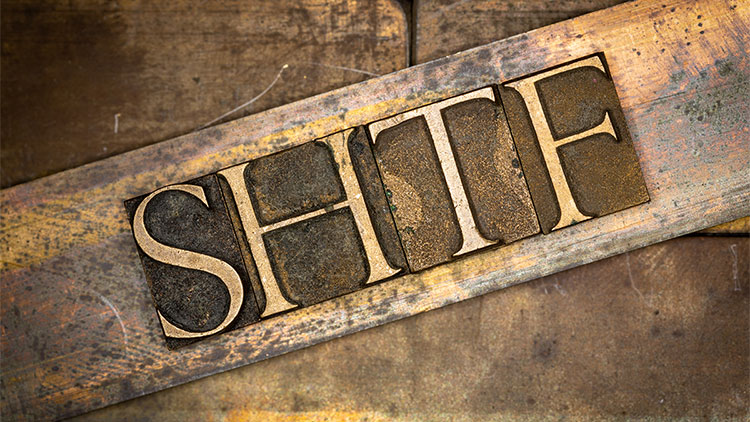
Too many preppers go into prepping blindly. They stock up on firearms and bulk ammo, grab some freeze-dried food, and then stuff a bug out backpack.Few preppers actually develop and follow an organized, prioritized SHTF plan.
This article will teach you how to:
- Prepare a personal profile that accounts for your situation,
- Define the threats you face,
- Realistically budget for your preps,
- Prioritize the items you should buy and the skills you should learn, and
- Create a personalized SHTF plan to address the threats on your list.
The Typical Prepper’s Path
New preppers are often prompted by fear first – and rightfully so. Modern society is exceptionally fragile despite, or more accurately because of, modern innovations. It’s an understandable mistake, diving in without a plan. They see what’s happening and think “this could happen here” and then look around the home and realize how unprepared they are. They rush out to buy some gear that might make them feel more secure.
I saw it after Y2K, Hurricane Katrina, Covid-19 pandemic, and most recently, the war in Ukraine. I’ve seen it play out countless times. Each big disaster-like event brings droves of people into prepping.
Retailers love it when this happens as they sell their products on fear. “Is your family safe? Buy this!” is the idea – and it works! People can’t open their wallets fast enough, rarely asking themselves whether they actually need the product, or if there might be a more practical approach to prepping.

Following the plan I lay out here, you will evaluate your current situation, the possible threats you face, the items you might need, and the skills you should build to create a safety net specific to you. Do this and at no point will you be manipulated with fear mongering to max out credit cards on wild, panicked purchases.
Practical Prepping
Practical prepping is different from how the media portrays prepping.
“Reality” prepper shows like Doomsday Preppers don’t help anyone prepare. They portray their cast as flat, one-dimensional extremists concerned about single events: terrorist attack, nuclear war, super-volcano eruption, or fiscal collapse. They stare into the camera, and with an exaggerated seriousness proclaim, “I’m preparing for a polar shift. That’s why I converted my home into a doomsday castle.” Specific threats make for good drama, especially with a completely random scoring mechanism to ratchet up the manufactured tension. Single-event planning is a lousy approach to prepping.
Practical prepping is a lifestyle. It embraces preparedness in a much simpler way than building a fallout shelter or buying cabin deep in the woods – as appealing as those options may sound!
Practical prepping follows a plan that accounts for your specific needs. It is done consistently over time and yields the most reward for your time and money. Buying 2,000 rounds for each of your favorite firearms all at once would be great but buying 100 rounds a month as you build a garden, learn how to purify water, and take a medical class will make you more resilient in a crisis.
The long-term result of methodically prioritizing your efforts will be a stronger position in both scope and depth. A bulk ammo deal may be worth grabbing, but it should be done from a SHTF plan that accounts for those decisions when the opportunities arise.
Practical prepping is realistic. Prepping for tough times is a marathon not a sprint. Marathons require training, and training requires planning.
Fear clouds vision and warps perspective. What if you spend all that time and all that money and it’s all for nothing?
Practical prepping reduces the odds of that happening by focusing on the products, skills, and knowledge that can benefit you and your family regardless of what happens.
Practical prepping saves money. Consistent execution of your practical SHTF plan will leave you safe in your home while the world around you tears itself to shreds over rolls of toilet paper.

When COVID-19 hit, practical preppers already had a healthy supply of everyday household items. They could shop for a few last-minute items without sweating the fact that X, Y, or Z products were out of stock.
Practical prepping is efficient. You want to build a resilient, flexible plan where each decision or purchase you make supports the one before it. The Stacking Principle that I will explain will help add layers of protection. Each new product or skill builds on the last.
How to Build a SHTF Plan
Everyone should prepare, but everyone should first prepare to prepare. Put pencil to paper and define your current situation. Clarify the possible threats you’ll face. List a few of the things you’ll want to keep on hand, and come up with a roadmap to a successful, personalized prepping plan.
Grab a pencil and notepad. The process is going to yield a much more robust plan than what you’ll find at Ready.gov. As you progress through this planning, you’ll want a few three ring binders or file folders to properly organize your plan and adjust it over time. Using Microsoft Word, Excel, or some other software will also work. I like to use Excel for this.
Planning is an ongoing, evolving process, and the right tools make it easier. But if you prefer electronic devices for writing and editing, keep plenty of paper and ink cartridges on hand. Printing plans on paper will make the process feel more formal, adding to the commitment.
Step 1 – Develop a Personal Profile
Ancient Greeks coined the maxim, “Know thyself.” Self-awareness is a foundation that enables you to build on your strengths while mindful of your weaknesses.
Write these characteristics down and expand on what they mean for you and your situation.
Age. How old are you? What can you contribute to the physical work that will need to be accomplished? What health considerations do you face? With age, supposedly, comes wisdom; what have you learned?
Finances. Financial stability is a critical factor in personal preparedness. Are you drowning in debt? Recently win the lottery? Have a little savings and a decent job? Prepping involves spending money – planning and practical prepping allows you make the most of what you have. Figure out how much discretionary money you have for prepping. Build a budget.
Skills. The abilities you’ve already developed are assets to build on. Are you a cook, experienced in storage, prep, serving, and cleaning food? Were you military or law enforcement, disciplined in security procedures? Are you a mechanic, welder, electrician, or carpenter, able to produce products from various components? Have you had medical training? Do you know how to hunt, farm, or fish? Everyone has skills – account for them as strengths.
Family. How many people do you have in your immediate household? Is there extended family you’re close to? Who do you care about enough to feel responsible for if SHTF? Do the people you’d take in have others they would want you to take in? While an unflattering term, this is called the baggage list – the extended group you’re agreeing to include in your plans and everything that entails.
Community. What’s the general community around you like? Is your home nestled in a snug suburban neighborhood? Do you live on a sprawling rural spread surrounded by well-known families? Are you in dense urban apartments? Has the neighborhood been seeing more crime recently or has there been an influx of out-of-staters? Do you know your neighbors? Assess the strengths and weaknesses of your community.
Geography. Is your part of the world prone to hurricanes or tornadoes? Are blizzards a threat? What about flooding? Do you live near a desert or in the forest? Are you in the mountains or live along the shore? The landscape surrounding you will dictate many aspects of your plan.
Complete Profiles for Family as Well
Once you have a personal profile built, expand by adding profiles for the rest of your household as well as the others you listed when considering those outside your own home you would want to care for. Completing this information for the others on your list will bring to light information you might not otherwise consider:
- Will you need daycare, entertainment, or education for children?
- Are there medical conditions that require special attention?
- What hurdles will there be gathering the group together due to communication, distance, or terrain?
There’s also the issue of commitment: who will show up when things go wrong versus who is willing to help with the plan? What will each person contribute? In what ways are they even able to contribute? How do you balance one person who’s broke but highly committed, and another who can spend plenty on preps but is unwilling to work?
You can see how intertwined these issues quickly become. We’ll talk more about groups later, for now understand that you can’t do it alone, but the more people involved the higher the likelihood for conflict. Group dynamics is a complex subject, but it’s something you must contend with.
Track Daily Life
Part planning means establishing baseline. Understanding what you do and what you use today will point the way in planning for tomorrow. Make a list of the events and items done or used regularly. Keep it on you and update it throughout the day.
Coffee drinker? Having coffee beans stored with a hand crank grinder might be a welcome dose of normalcy in a stressful situation. If you’re a voracious reader, you might prioritize spare reading glasses and extra books instead. The electricity going off doesn’t stop the need to do laundry. Do you have a way to wash laundry off-grid?
A generator might be a first step, but “stacked” on top of that (or in place of that depending on your situation), you may have a washtub, detergent, hand agitator, and clothesline on your list. Entertainment, especially with children, means having board games, card games, coloring books and crayons on hand.
Food and water are the most important aspects of personal preparedness. Putting some thought into the meals you eat frequently enables you to stock up on food you actually want to eat. Food you are accustomed to eating. Good food inevitably makes a bad day a little better.
Imagine preparing a meal when a storm has caused a power outage, the roads are impassable, and the food in the fridge has gone bad. Would comfort food make that situation slightly more bearable? Sure, it might be fun for the family to dive into that freeze-dried food storage for novelty’s sake, but what about day 2 or 3? There is something to be said for normalcy, which is why our minds tend toward normalcy bias in the first place.
This counts for water, too. Track your use of it. How much do you drink in a day? How much water do you use to cook your meals? How many showers does your family take? You need to get your head wrapped around personal consumption to assess your true water needs. Yes, you may not need to shower every day in a collapse situation, but you can account for that once you have established baseline, and that involves tracking what you use.
Step 2 – Develop a Threat Assessment
A threat assessment is going to take a realistic look at the threats you face. Often, what is most likely to happen is the easiest to prepare for. That’s a good thing. The least likely events are often the most severe and require the most prep work.
As you progress along your plan, you add more layers of preparedness, “stacking” preps on top of preps as you work your way from the most likely and mildest SHTF situations to the least likely yet most dangerous SHTF situations.
A logical assessment of the likelihood these threats are to materialize will focus your efforts. Having a clear vision regarding the threats you face will define goals and prioritize purchases. Unless you’re made of money, efficiency goes a long way when preparing for a bad day. A well-thought-out threat assessment will sharpen your focus.
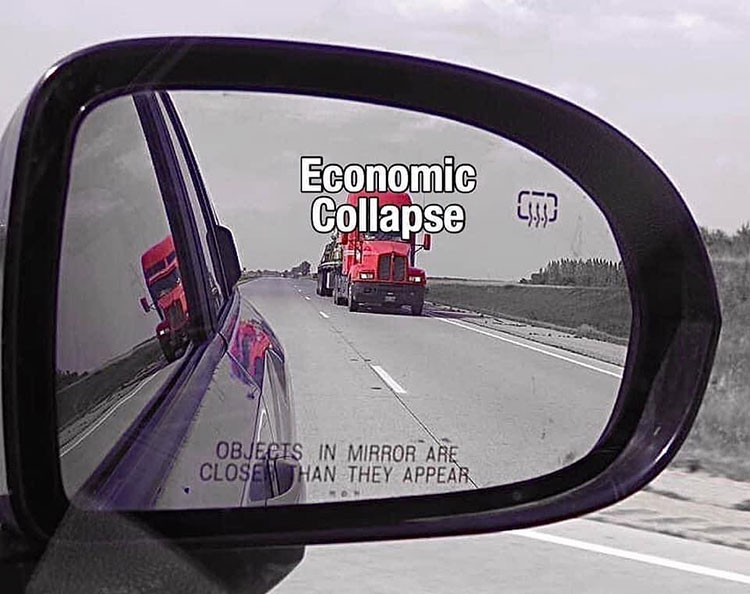
Start by making a list of everything you can imagine going wrong. No event is too small, none too large. This is simple brainstorming. Write down everything that comes to mind. By the end of it you should have a sizable list.
Use your personal profile. Consider where you live. Living in Maine, an ice storm could easily cut power for weeks. If you live in Nevada, drought is a bigger concern. If you live in California, it might be wildfires or earthquakes. Those are just a few natural disasters, however. Other events could have more severe consequences.
Download my SHTF Plan Example Spreadsheet if you find it useful for following along.
Without any intention to sway or influence your catastrophe catalog, here’s a screenshot of the list I made:
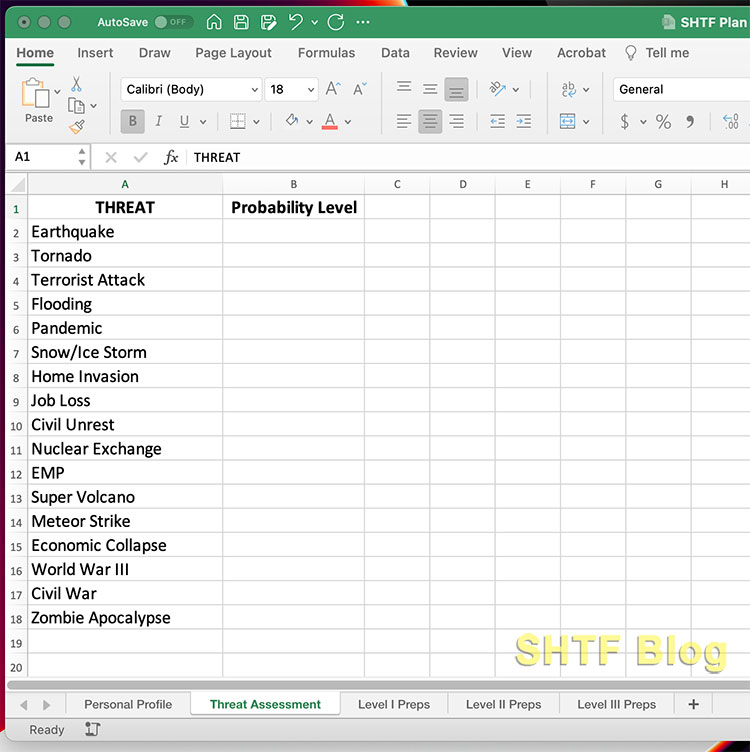
Group by probability. Once your brain has hit a wall and your list is complete, take everything you wrote down and group the threats by likelihood into three categories:
- Level I – Most probable
- Level II – Somewhat probable
- Level III – Least probable
Determine which threats rate higher than others. It’s easy to imagine a power outage or job loss happening, but harder to imagine a super volcano blowing off. Historically, a burglary or short-term natural disaster is more probable than economic collapse, and an economic collapse is more probable than an asteroid strike.
Remember, this is a threat assessment for your situation. Do not look at global probabilities of a war if you don’t think it’s coming to your area of the world, though repercussions of it—like higher energy prices and supply chain shortages—might. In rural Maine, I’m not too worried about a tornado, but storms cause power outages multiple times a year.
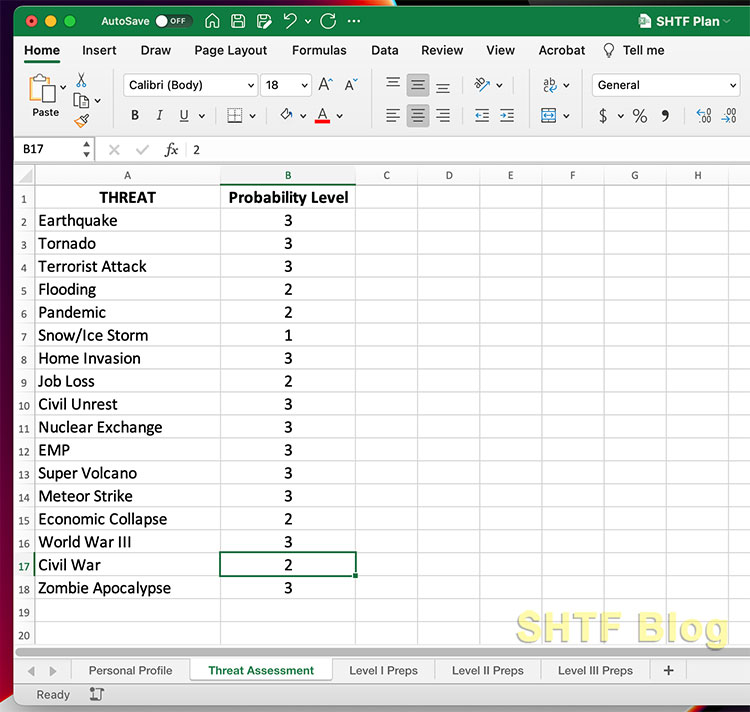
Move items up and down until the list feels right. No one can dictate what concerns should weigh heaviest for you. You’re in charge of your plan. You can always adjust it later; in fact, you should adjust it as time goes on and circumstances change.
Consider scope versus probability. You likely found an inverse correlation between event size and probability. As the size of the threat increases its probability falls. The worst things are also the least likely.
The good thing is that the more likely events – due to their limited scope – require fewer supplies and skills. What you need for a natural disaster is less than what would you need to survive a nuclear war.
However, most of those natural disaster supplies will also help you in a nuclear crisis. With this Stacking Principle, once prepped for a natural disaster, you can keep prepping toward other events that are less likely but more deadly.
Step 3 – Make a Supplies List
Now it’s time to start thinking about what you need to survive the events in each threat level. Knowing what you and your family’s situation is and the threats you face, you can identify gaps in readiness.
Starting with the most likely events on your list, what you would need to get through them? Job loss or a short-term natural disaster would require what – food and water? Cash on hand? Security? First aid? Hand tools?
Think it through.
If you get stuck, go back to the list of things you use every day. If a storm prevented you from getting to the store and buying supplies, what would you miss the most? The items used most often is where to start a shopping list.
Break these items into separate lists by category:
- Security
- Shelter
- Water: Purification and Storage
- Food: Storage, Preparation, and (possibly) Production
- Medical
- Power/Lighting/Fuel
- Communication
- Hygiene
- Miscellaneous
Move up the list of threats, adding additional items you would need for you and your family. You are stacking preps, building your level of preparedness incrementally over time.
Levels of Preparedness
Another way of looking at threat levels is by time to recovery. By that I mean, how long will it take to return to normal?
You can look at the different levels this way:
- Level I: the ability to live on your own for 1 month.
- Level II: the ability to live on your own for 3 months.
- Level III: the ability to live on your own for 12 months.
Anything beyond that and you are looking at a higher level of personal preparedness that few achieve or even aim to achieve. That’s just fine, though. The ability to survive a full year into a collapse means you could survive just about anything.
Level I Prep List
Even if you only get through prepping for Level I threats, you will still be lightyears ahead of most people.
Write down what supplies and skills you need. Work through each of the categories I listed.
- Security may not be an immediate concern in the aftermath of many short-term emergencies, but it’s not a stretch to imagine situations where your immediate survival requires the ability to defend yourself, your family, and the supplies you’ve worked hard to acquire. Are you ready for that?
- Shelter may only mean a tarp and rope to cover a damaged roof at Level 1. However, a more purpose-driven survival tarp might be needed at Level 2.
- Having the most basic water purification methods more than doubles your chances of long-term survival in the worst circumstances.
- Most American families have less than three days’ worth of food on hand at any time. Building a prepper’s pantry would sustain you until roads are passable and stores are open.
- Having food requires the ability to prepare it, so cooking fuel options and store some spices.
- The most essential gear may be a medical kit to keep you alive when you’re injured. Paramedics are minutes away when seconds count. Do you have what it takes to save your own life or the lives of your friends and family?
- When the sun sets, your ability to function is decimated unless you have artificial illumination or the ability to start and maintain a fire. Flashlights, lighters, waterproof matches and fire starters will be critical.
- The ability to start a fire is pointless without a decent saw or axe to prepare wood to feed the flames. Do you have the tools you would need?
- Soap and hand sanitizer fight germs and prevent many illnesses and disease.
- A change of clothing, especially sturdy and/or warm clothing can make all the difference.
The screenshot I created is an example of how a well-designed SHTF plan begins to take shape. These are ideas needed to address each category on a Level I threat. Separate tabs are created for Level II and Level III.
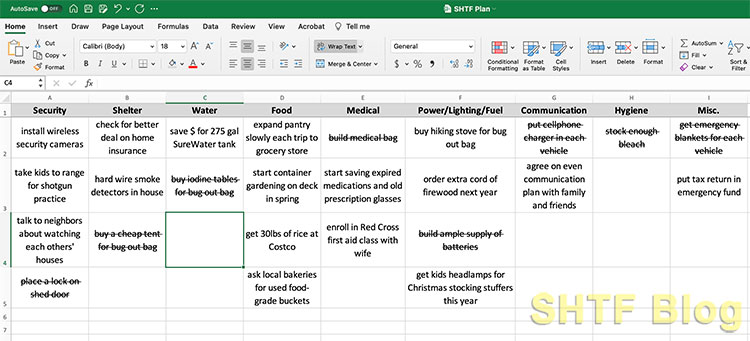
In the example above, I struck through anything that was already accomplished. You can just delete anything you accomplish but striking it through may help you see how far you’re coming along, and it can serve as an inventory. You can color code different cells, add hyperlinks to stores or articles, whatever. This is your list. Customize it.
3-Day Emergency Kit
A 3-day kit is also known as a “bug out bag.” This is a kit that will help you to evacuate and survive should you be forced to for a period of roughly 3 days. This is a short-term kit that will sustain you long enough to find shelter or travel to a pre-planned safe location.
You may plan to stay home and shelter in place, but the ability to go mobile at a moment’s notice is a critical Plan B, so the kit is built around a backpack on the premise that bugging out may involve going on foot. Starting with whatever bag you have is fine, however you’ll want to ensure it’s good quality and you may eventually want to step up to a designated bug out backpack.
Supplemental Supplies
Do you have a first-aid kit with Band-Aids, Neosporin, an ace wrap, Benadryl, and an ice pack? Every household needs a basic first aid kit. Add a tourniquet, pressure dressing, and chest-seal to build a basic trauma kit. With enough basic medical supplies, you’ll be ready to handle most simple emergencies.
Augment the jack and jumper cables in your vehicle with a flashlight, wool blanket, small toolkit, and a fire-extinguisher. You’ve started a vehicle kit.
Take what you already have on hand and supplement it with a few key items to round out your initial kit. You are now “stacking” on top of what you already have, adding layers of personal preparedness. It’s easier than you might think!
Gear Check
Whether you add items you already have, or are purchasing everything new, be certain that everything works properly and that you know how to use it. Open your gear, read the instructions, and try out every item. Opening your new portable water filter only when you actually need it could mean learning a part is missing. Know how to use all your gear and inspect your gear bags every 6 months.
Inventory
A simple inventory sheet clarifies what you have, and what items are still needed to round out your list. Tracking expiration dates is easier with a proper inventory sheet. You just cross out dates as you use a product, add dates as you add items. Make sure you are rotating perishables using the oldest first.
Level II Prep List
Level II threats are bigger than the everyday worries of Level 1, because the effects last longer. That means more planning and supplies to survive threats of this type. You are now moving beyond a one-month level of preparedness to something that will keep you and your loved ones safe for up to three months. This is a big jump and will increase the odds of your surviving any event!
You will create redundancy in the essentials from Level 1, following the “two is one and none is one” method of prepping. Expect failure. Additional resources improve the reliability of your preps. If one tool fails, you have a backup. Again, this is “stacking.”
Revisit your threat assessment and make any required updates. Compare that threat list against your supply list. Work through each category and itemize everything needed. As the perceived threat becomes more severe, the supply list grows. Patience and consistency pay off when you start looking at the scope of supplies needed.
Level III Prep List
Any crisis with effects lasting longer than three months will fall into Level 3. Level 3 represents a serious level of preparedness that only a small fraction of preppers ever achieve or even hope to achieve! There are reasons for this.
Prepping of this nature means preparing for far less likely tragedies, but they are tragedies that – if they happened – would be far more severe. At Level 3 you are most likely preparing for an EMP, World War III on home soil, or some other long-term TEOTWAWKI event.
Should a major event of this type occur, you would need a much larger stock of essential supplies, and more than a few items that didn’t make it on previous lists. Level 3 preparedness would likely mean a more significant change in your daily life. You could find yourself now maintaining a larger garden, saving seeds, buying more freeze-dried foods, etc.
Prioritize. Once again, compare your threat list to your inventory list and evaluate which purchases will yield the greatest benefit. Prioritize them over other purchases, regardless of how sexy those may be. Building a fallout shelter and buying night-vision gear may end up being “stacked” on top of hand crank radios, knives, shovels, and firearms.
Long-term disruptions in day-to-day life makes basic tools more important. There’s significant decision making to be done when organizing the shopping list. A solid SHTF plan gives perspective into your needs versus wants.
Plan for resilience. Long-term, worst-case scenarios inevitably include widespread shortages. If retail establishments manage to stay open, their inventory will be sparse at best. Tools and parts become precious as the work you can perform and equipment you can repair is more valuable than gold.
How long will your solar array function, and can you overhaul it when its capabilities degrade? Has your fuel storage been adequately stabilized so your machinery continues to run? Rechargeable batteries wear out. Will your flashlights be working in a year?
Step 4 – Make a Skills List
Repeat Step 3 with a focus not on products but on skills. Buying a water purifier is as easy as clicking a few buttons online. Learning how to collect water in the wild, that’s something quite different. You might have an all-weather lighter, but do you actually know how to start a fire in the rain to cook a meal?
Every bit as necessary as the materials you purchase are the skills you learn. Again, you start with the basics and stack knowledge, learning more as you go. If you did a crash course in ham radio and now have your Technician License, study for the General License.
Knowledge is power.
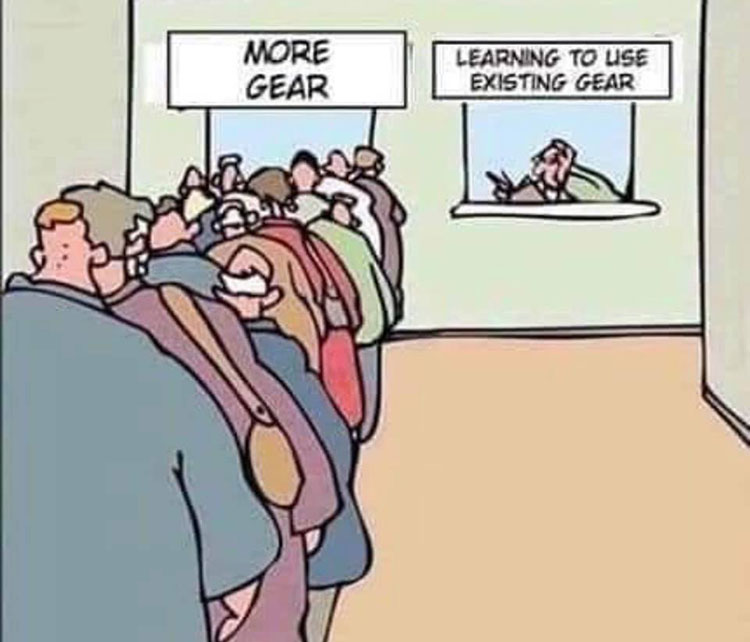
People that have more money than time will fine this step the hardest. In fact, it’s hard for almost everyone. Learning a new skill is not difficult but making the time for it might be. Life’s everyday priorities get in the way. You need to go buy groceries, you worked late, the kids need to get to soccer practice. Who has spare time for prepping!?
Make prepping fun. That’s my advice. I can keep prepper skills sharp, and pass them on to others, by going hunting, fishing, hiking, and camping. I can get fresh air and eat fresh, organic vegetables by teaching myself how to garden. The journey is just as important as the destination.
Your skills list should coincide with your priority list and threat levels. The most common threats can be overcome with the simplest skills. More advanced threats require more training. Everyone should learn CPR and basic first aid in Level 1. Becoming a Wilderness First Responder might be what you want at Level 2. Level 3 might mean becoming an EMT. These are just examples. You get the idea – skills stack, too!
Step 5 – Implement a Stacking Principle
You probably understand the idea of stacking now. Building a castle begins with blueprints. Materials are collected, and construction begins with a foundation. Blocks are laid row by row, each level resting confidently on the blocks below.
Practical prepping utilizes this building block approach. Build each segment of preparedness evenly to maintain balance. Add some water, then food, then medical supplies, then security, then communications. Then add more water, more food, and so on.
Again, practical prepping will save you money as you focus on covering essentials first, then building depth across all categories and threats. You can better accomplish long-term goals if you’re wise with initial investments and follow your plan.
Level I Example: Water
The basics. A practical prepper understands that water is critical to survival. You purchase a bottle of water purification tablets. You stick them in a backpack with an old, beat-up military surplus canteen and toss it in the bug out bag you’re building. You have just improved your odds of survival.
Consistency and redundancy. After addressing other needs, you turn your attention back to water. Those tablets will be perfect in the right situation, but they will not carry you and your family through a month’s worth of water needs. So, you stack on top of that by ordering a portable water filter.
You put the new filter in your pack and move the purification tabs and canteen to one of your vehicles. You’ve multiplied your resources and increased your ability to safely supply water for yourself and your loved ones.
Adding depth. You stack even more supplies in your other categories and come back to water, now focusing on your home. Maybe you lack the space needed for serious amounts of water storage but have enough room to add a mid-sized water storage container.
Level II Example: Water
It’s been a year since you implemented your SHTF plan, and you celebrate by ordering a six-gallon Crown Berkey Water Filter and a dozen black filters. Your home and vehicles are now outfitted with layers of water purification and storage options. You feel confident that between all this your family has enough water for three months.
Level III Example: Water
After making more passes through the different preparedness needs, you reevaluate your threat assessment and decide to bump water back up the priority list and commit some time and money. You don’t only want to drink water, you want the ability to clean clothes, dishes, and your body – as well as water the garden.
A little studying shows you how to install rain barrels under each gutter. You ensure the system will guard against mosquitoes laying eggs in the stagnant water and build the means to both use the water for irrigating your garden and filter it for personal use.
Your prior water preps focused first on purification and storage. Now that you have those areas secured you focus on collection. The rain barrels will help. You may also decide to hand drill a well. Whatever you decide, your focus is now on surviving events over a longer period – up to twelve months!
Example of Stacking Skills: Gardening
As stated before, prepping is not just the accumulation of things. Here is an example how gardening skills can stack over time.
Learning through trial and error. Growing up in the suburbs, you weren’t exposed to a lot of gardening, but you want to learn. While you’re at the big box hardware store you buy small basil and rosemary plants, and two tomato plants. The herbs you start indoors, and the tomato plants sit on the porch in large planters.
You overwater the herbs, causing fungal infection and killing the plants. The tomatoes do great though, and deliver a delicious, fresh crop all summer. As the summer ends however, a sudden plague of pests descends and devours those tomatoes on the vine, cutting your harvest short.
Staying consistent. Through the fall you watch YouTube videos by The Gardening Channel and Self Sufficient Me. You look up the local Cooperative Extension Office and research which varieties of fruits and vegetables grow best in your climate.
The first of the year finds you ordering a Fedco Seeds catalog and purchasing Square Foot Gardening. You select seeds and plants that are hearty – resistant to disease and pests.
Being realistic. You manage to curb your enthusiasm and reign in the impulse to attempt a large plot. Instead, two 4’x10’ raised beds accompany an 8’x10’ ground plot. You also plant a few flowers around the edge of the garden bed to attract bees. A beehive will wait for next year.
For now, you try to replicate your success with the tomatoes, and have an organic insecticidal soap on hand should the pests reappear. On a whim you build a potato tower and alternate layers of straw, dirt, a few seed potatoes, more dirt, and more straw. A hearty variety of apple tree is planted with a mind towards more fruit trees and a grape vine and trellis for it to grow on.
Learning lessons. Next year you’re going to plan better for succession crops. You’ll also take better notes on which seeds and plants do better than others, what issues you face with pests and disease, and the weather. You also jot a few notes on sprinkler system ideas.
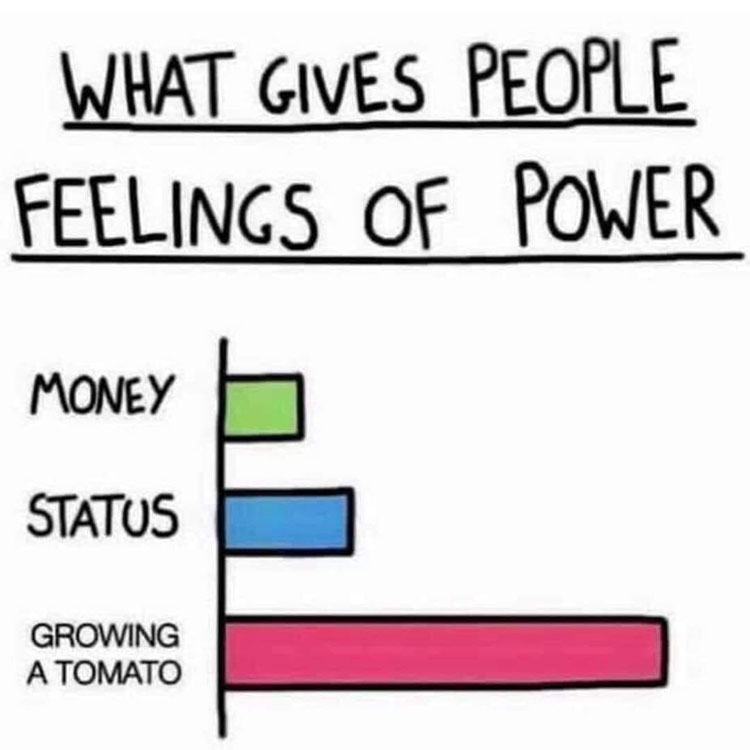
Step 6 – Develop a Survival Strategy for Each Event
More important than a full stockroom are the steps you take after a crisis strikes. Now that you have a picture of your personal situation, the threats you face, the gear you need, and the skills you must learn, you can begin looking at what you’ll have to do to survive a disaster.
The first question most people will ask themselves when debating a particular threat is should I bug in or bug out? The answer is always going to be “it depends.” It depends on the location of the event, the severity of the event, and how it is developing. The only clear answer comes in retrospect.
These are some of the kinds of questions you’ll have to ask to yourself:
- Should you bug out, and if so, under what circumstances. Do you even have a place to go?
- Will you take in your sister-in-law and her family if they need help? What are your expectations of them if you do?
- Does everyone know where to meet if cellphones go down? What if someone doesn’t arrive? Is there a backup location?
- Do kids know what to do if they hear a window break in the middle of the night?
Meet with Your Group
Make sure everyone knows the designated assembly spots in each situation. Consider a neighbor’s covered porch if your own home isn’t an option but give them a heads-up you’ll be coming!
Favorite restaurants are solid rally points even if they’re closed. When deciding on places out of town to gather, identify landmarks or buildings common to every city. If communications fail, does everyone know to unite at the First Baptist Church of whatever town you bug out to?
Plan for contingencies. Consider that situations are often dynamic. Plan A might simply be to meet at home if anything goes wrong. Partway home the situation takes a turn, and you end up an hour from the house as emergency personnel block streets and detour traffic. Do you have a Plan B?
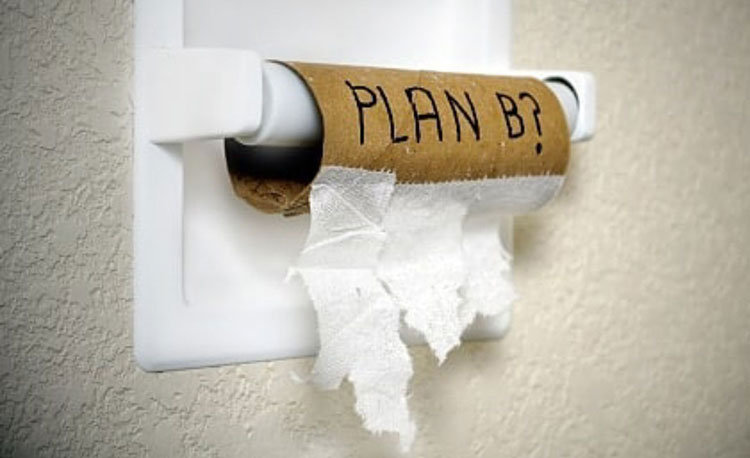
There needs to be enough flexibility built into the plan to adapt to the inevitable changes. A concrete foundation is imperative, however significant adaptability makes for a stronger overall plan.
Develop initial steps. After meeting plans are set, define necessary tasks for each contingency. If a major storm hits, would the first-person home know what to do? Should your oldest child be home alone when a crisis hit, would the plan direct them to fill the tub and sinks with water first or close all the windows, blinds, and curtains? Would your spouse know what to pack first if it came time to bug out? Does the plan detail which events would force you to abandon your home?
Written Strategy Example
Depending on your family situation, it may make sense to put your plan down in writing and sorted in a three-ring binder. A basic survival strategy might look like this:
- Meet in the basement of the house.
- Locate appropriate binder in third drawer of file cabinet, pull binder, follow steps as outlined to the best of your ability and understanding.
- PRIMARY: Secure yourself and the residence as outlined in Security Binder A, page 1
- SECONDARY: Secure water sources as outlined in Water Binder A, page 1
- THIRD: Contact all family members immediately as outlined in Communications Binder A, page 1
Security Page(s)
- Acquire a means to defend yourself.
- Firearms are located in the following locations:
- Magazines, and ammunition are in the basement safe
- Combination 12, 0, 17
- Magazines, and ammunition are in the basement safe
- Additional ammunition in basement safe room to right of stairs, on shelves to left of door, in cans marked by caliber
- Firearms are located in the following locations:
Water Page(s)
- Fill all sinks with cold water.
- Locate Water Bob x2 in safe room on shelves to left of door, far right shelving unit, front right corner, above toilet paper.
- Place in both bathtubs
- Fill with cold water
- Locate Big Berkey water filter in safe room, on shelves to left of door, far right shelving unit, far left corner, above toilet paper.
- Place on kitchen counter
- Insure 3x filters installed
- Fill with cold water
Communication Page(s)
- Send text message “The Bills are All Due Today” to following phones numbers:
- (123) 456-7890
- (234) 567-8901
- (345) 678-9012
- (456) 789-0123
- (567) 890-1234
- Turn on Baofeng radio, mounted to wall on right of doorway inside safe room:
- Ensure Frequency tuned to 520.980
- Monitor frequency on the hour and every 20-minute interval: 20 past, 40 past
Your first draft may only have 5 pages in a single binder, and that’s great – you have a plan and it’s written down. If you have a plan in place, no matter how primitive, you’ve already done well!
Step 7 – Match Finances to Your Plan
Finances are among the top reasons people quit prepping. Start with getting a handle on your finances. This is not financial advice, just ideas to consider.
Unless you’re independently wealthy, a large portion of your SHTF plan will revolve around what to get when and which skills to develop in what order. This is easier when you’re not stressing about money. If you have a significant other, discuss this together and come to an agreement on a household budget.
Track your spending. You must know where your money is going to make wise decisions about prepper purchases. Keep receipts for cash purchases for one month. At the end of the month, group your spending into categories such as food, utilities, transportation, entertainment, etc.
Do some forecasting. Now that you can see where your funds are going, it’s decision time. Create a budget and forecast where you want discretionary money to go. If you want to spend money on projects and supplies, you’ll need adequate finances. This means making more money or spending less in other areas.
Is your family’s safety worth a few hours overtime? A part time job? Fewer meals out? Spending less on a vacation? Wise decisions include the opinions of others in your family. The answers will differ for everyone.
Pay down debt. More debt means fewer options. Your instinct may be to take out another loan or use a credit card. Do the opposite. Rather than taking on more debt, pay debt off. Once more of your money is available, you’ll have more options, and options are good.
Next Steps and Strategies
If you took all the steps I outlined above, you now have a practical SHTF plan. Congratulations!
You’re not out of the woods, however. In fact, if you keep stacking preps and skills, you’ll never be out of the woods. This is okay. Remember, practical prepping is a lifestyle.
Execute your plan. Now that you have a direction of travel, take the first step. Don’t wait. Don’t procrastinate. There will never be a perfect situation to make the changes you’ve outlined. Carve out the time and money now and do what needs to be done.
Consistency is king. Buy two Mountain House long-term storage meals every single payday and toss them in a tote. When you can afford to do more, pick up a third pouch or even order a case, but set a goal for steady purchases.
Stay sharp. More important than your deep larder or arsenal are skills; the know-how and abilities you have. These need to be practiced and improved. Read books, blogs, and magazines. Watch prepper movies, shows, and videos. If it’s been a while since last First-Aid or CPR class, get re-certified. Take your gear out of the bag and review its functions and features.
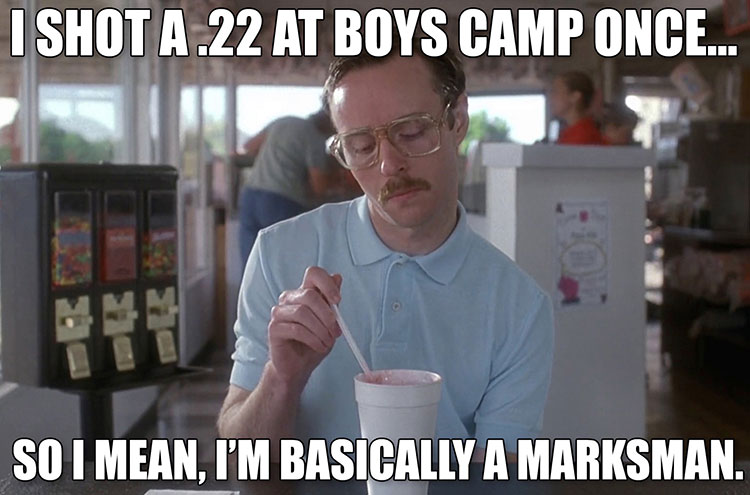
Review your plan regularly. This isn’t a ‘one and done’ exercise, but a plan you must visit and revise. It’s a living document. Keep the plan current as instability and unrest rises and subsides, as your life situation changes.
Update your inventory. Know what you have, where it is, and when it expires. Don’t rest on previous purchases that have been lost, spoiled, or gone dead. Maintain what you have as you add to it.
Make prepping fun. Go camping and practice your skills and try out the new techniques you’ve learned. Start a fire, purify water, use a map and compass when you go hiking. Even reluctant family members will enjoy a day trip and learn skills if you start small and stay consistent.
Don’t get burned out. Trust me, it’s easy to get burned out if you go too much too fast. It happened to me early on. I had to take a break from prepping.
Keep the big picture clear in your mind. You’re building a safety net for yourself and those you care about. This will take time to complete, so plan for the long hall. Following a well thought out plan prevents burnout, paralysis, and panic. Regular steps toward a realistic goal will achieve long term success. There is no end to learning skills, practicing techniques, or filling gaps and adding depth to essential supplies – take the time to set a reasonable pace.
With a plan and consistency, you can be ready to face any concern. Good luck!

5 comments
Your spreadsheet looks SOOO much better than mine. Is there a way i can get a copy so that i can modify with my info that i have? I’d appreciate it…..thank you.
Funny, I almost did that when I was writing it, but I figured it wasn’t thorough enough and people wouldn’t download it anyway. I just loaded a template in the article. It’s in a yellow box for download. Thanks for the comment.
The file is saying “Access Denied” when I attempt to download.
Thanks for mentioning. We underwent a site transfer. The file is fixed now.
Great Ideas. As I typically get my cart before my horse, I am diligently working on your points #4 and #5. Next, I will work on point #3 while incorporating points #1 and #2 into my comprehensive plan. Your points are a great way to organize this effort. I believe that organized efforts are far more likely to get done, than great ideas that are never made actionable items. The key I think is to make small, achievable goals, and check them off one-by-one. Eventually, you will have achieved a great effort in time and resources.
1. Prepare a personal profile that accounts for your situation,
2. Define the threats you face,
3. Realistically budget for your preps,
4. Prioritize the items you should buy and the skills you should learn, and
5. Create a personalized SHTF plan to address the threats on your list.